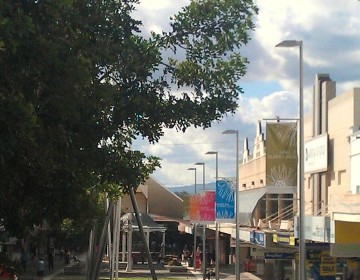
In The Mall… What’s it all about?
- December 28, 2014
- / Category Marketplace Evangelism, Ministry, Mission to the Marginalised
- / Posted By Kevin Bennett
- / No Comments.
Contents
Introduction
 I was asked to compile a brief story about what I’ve been up to. Much of this story comes from other blog posts, but there’s also some unique content here. It’s a bit of a summary/roll-up.
I was asked to compile a brief story about what I’ve been up to. Much of this story comes from other blog posts, but there’s also some unique content here. It’s a bit of a summary/roll-up.
When the drop-in center at which I was volunteering (called “The Chat Room”[1]) closed down in 2012, I noted the dismayed reactions of the clients and pondered what sociological needs had been filled by that service, and therefore, what would be lacking when it closed.
In my prayer time I was also becoming convinced that God wanted me to take a peculiar course of action, which amounted to something like, “an unstructured observation session in a public space”, but was called, “go and sit over there and just observe for a while. I have something to show you”.
I did that in Ipswich Mall one afternoon in early 2012, and the experience revealed how God was planning to reach into the very heart of the City of Ipswich.
Method
I simply sat in the Mall, Bible beside me, watching people move around for several hours.
Observations
As I sat, I noticed two distinct people groups which scarcely interacted with one another. In fact they seemed so indifferent that each could have been invisible to the other. The groups were made up of middle-class people on one hand, and members of the street culture on the other.
The middle-class were just passing through, or accessing the retail businesses in the Mall. The others were, for want of a more constructive term, loitering. They were congregating in groups, exchanging trivialities and coarse insults, engaging in petty drug deals, and generally killing time. Some of them were known to me from my association with the drop-in center.
As I was reflecting on the significance of the distinction between these two people groups, an elderly man came towards me, seemingly with purpose. He stopped in front of me and asked if my book was a Bible, to which I replied, “yes”.
 He said, “Are you waiting to meeting someone here?”
He said, “Are you waiting to meeting someone here?”
I said, “Yes, I think so”.
He said, “You’re not sure?”
I said, “I’m not sure that I’m still waiting”.
He proceeded to tell me about the surgery he had just experienced, which consisted of a plate installed in his head, and about his ailing wife, for whom he is a carer. We chatted for ten minutes or so, during which time I was able to express understanding, offer encouragement to him, and also to give warm affirmation of his faithfulness to his marriage.
The conversation apparently satisfied the man, who then went on his way.
Interpretation
I interpreted the man as, “everyman”. People have a tremendous need for interpersonal validation in order to function well, and this man needed someone to hear his concerns and to validate his life experience. That is what “everyman” needs.
The people of the street culture lack precisely these things. Their interpersonal relationships are characterised by poor conflict resolution skills, poor self-image, and poor transactional analysis skills, and all seem to be dealing with unresolved trauma. In many cases these poor relationship skills are inter-generationally inculcated. God’s desire, in showing me this, was that these people should have access to relationships through which their sociological needs are met. I was to form a community of such relationships, in Jesus’ name, within their cultural setting.
Action
So on 29th May 2012, I began gathering people in the city’s central mall area as a small community, and that process continues to this day on a weekly basis. I have dubbed the experience “Marketplace Christianity”.[2]
 This community consists of people from all walks of life, prominently including drug addicts and homeless people, the mentally unwell, and criminal class, but also people more readily characterised as “middle class”. One of the fascinating things is observing who thinks of themselves as “the helper”, and who thinks of themselves as “the helped”. I reflected on that and its implications for empowering people, in the second week of the exercise.[3]
This community consists of people from all walks of life, prominently including drug addicts and homeless people, the mentally unwell, and criminal class, but also people more readily characterised as “middle class”. One of the fascinating things is observing who thinks of themselves as “the helper”, and who thinks of themselves as “the helped”. I reflected on that and its implications for empowering people, in the second week of the exercise.[3]
Indigenous Australians
Although “the street” is a distinct sub-culture, it is not the only important cultural divide in Ipswich. The Indigenous community, a numerically prominent group,[4] encompasses a kaleidoscope of cultural symbols, some of which are traditionally Indigenous, some Christian, and some modern-secular. Individuals frequently have trouble navigating the mixture, and groups become estranged over the interpretation of these ambiguities.
I helped some local Indigenous men to set up and run an Indigenous youth organisation,[5] and what I learned of their cultural milieu led me to reflect on how little the Gospel actually mandates any cultural mores at all.[6]
A number of Indigenous people wanted to meet for a Bible study, so I facilitated that with a food hamper initiative.[7] The initiative ran out of steam when I ran out of money to provide food hampers for attendees, and I learned a valuable lesson about “Rice Christians”.[8] In traditional Indigenous culture the connection between “leader” and “provider” is very strong, encompassed within a relational concept called “kanyirninpa”.[9] McCoy observes that “missionaries who fed [the people]” were unwittingly invoking a “patron-client” relationship related to kanyirninpa.[10] I had not wanted to fall into that trap, but arguably did.
 For that reason, when I later created a community in the Mall, I was determined not to involve money in any way. This was brought into clear focus when one friend said that he wanted to “tithe” to the “ministry in the mall”. I refused it, taking the opportunity to reinforce: 1, that the truth is free, and 2, that I would rather receive one person who wants the truth than 99 who want coffee, or a sausage, or anything else that money can buy.
For that reason, when I later created a community in the Mall, I was determined not to involve money in any way. This was brought into clear focus when one friend said that he wanted to “tithe” to the “ministry in the mall”. I refused it, taking the opportunity to reinforce: 1, that the truth is free, and 2, that I would rather receive one person who wants the truth than 99 who want coffee, or a sausage, or anything else that money can buy.
What I have learned
 The Gospel is the reconciliation of all humankind, both with one another and with God (Ephesians 2:11-22). As I experience community across cultural boundaries, I find endless exciting ways by which the Gospel does this.
The Gospel is the reconciliation of all humankind, both with one another and with God (Ephesians 2:11-22). As I experience community across cultural boundaries, I find endless exciting ways by which the Gospel does this.
I have learned countless other things, some of which I manage to blog.[11] Most importantly, I have learned a lot about the Kingdom of God: I have learned how to express the transcendent love of God in ways that drug dealers, addicts, the downtrodden, both the victims and the perpetrators of violence, the marginalised, and various other “sinners” can relate to directly. In doing so I have learned something of why Jesus valued “reclining with sinners” (Mark 2:16-17).
I have observed that this exercise has begun to inculcate the street culture of Ipswich with an authentic Christian narrative in its own terms.[12] This will, I sincerely trust, become a self-sustaining local movement not reliant on the established church culture, nor on money, both of which constitute foreign cultural symbols. Nor will it rely on me.
Bibliography
Australian Bureau of Statistics, “Indigenous Regional Profiles (Census 2011),” Accessed 5th August, 2013, http://www.censusdata.abs.gov.au/ABSNavigation/prenav/LocationSearch?locationLastSearchTerm=ipswich&locationSearchTerm=ipswich&newarea=LGA33960&submitbutton=View+QuickStats+%3E&mapdisplay=on&collection=Census&period=2006&areacode=LGA33960&geography=&method=Place+of+Usual+Residence&productlabel=&producttype=QuickStats&topic=&navmapdisplayed=true&javascript=true&breadcrumb=PL&topholder=0&leftholder=0¤taction=104&action=401&textversion=false&subaction=1 .
Bennett, Kevin, “Chat Room”, Accessed 22nd July, 2013, http://www.onefaithonechurch.com/index.php/chat-room-2/ .
———, “Marketplace Christianity – in a Marketplace!”, Accessed 22nd July, 2013, http://www.onefaithonechurch.com/index.php/marketplace-christianity-in-a-marketplace/ .
———, “Men of Biami Blog”, Accessed 22nd July, 2013, http://men-of-biami.webs.com/apps/blog/ .
———, “The Naked Gospel”, Accessed 22nd July, 2013, http://www.onefaithonechurch.com/index.php/the-uncultured-gospel/ .
———, “On Earth as It Is in Heaven”, Accessed 27th July, 2013, http://www.onefaithonechurch.com/index.php/on-earth-as-it-is-in-heaven/ .
———, “One Faith One Church”, Accessed 22nd July, 2013, http://www.onefaithonechurch.com/ .
———, “Street Links 2012 – God Does Not Show Favouritism.”, Accessed 22nd July, 2013, http://www.onefaithonechurch.com/index.php/streetlinks2012/ .
———, “Un-Church the Church”, Accessed 22nd July, 2013, http://men-of-biami.webs.com/apps/blog/show/9958907-un-church-the-church .
McCoy, Brian F. Holding Men : Kanyirninpa and the Health of Aboriginal Men [in English]. Canberra, ACT: Aboriginal Studies Press, 2008.
Wikipedia, “Rice Christian,” Accessed 22nd July, 2013, http://en.wikipedia.org/wiki/Rice_Christian .
- Kevin Bennett, Accessed 22nd July, 2013, “Chat Room”, http://www.onefaithonechurch.com/index.php/chat-room-2/. ↑
- Accessed 22nd July, 2013, “Marketplace Christianity – in a Marketplace!”, http://www.onefaithonechurch.com/index.php/marketplace-christianity-in-a-marketplace/. ↑
- Accessed 22nd July, 2013, “Street Links 2012 – God Does Not Show Favouritism.”, http://www.onefaithonechurch.com/index.php/streetlinks2012/. ↑
- “3.4% were Indigenous persons, compared with 2.3% Indigenous persons in Australia.” – Australian Bureau of Statistics, “Indigenous Regional Profiles (Census 2011),” Accessed 5th August, 2013, http://www.censusdata.abs.gov.au/ABSNavigation/prenav/LocationSearch?locationLastSearchTerm=ipswich&locationSearchTerm=ipswich&newarea=LGA33960&submitbutton=View+QuickStats+%3E&mapdisplay=on&collection=Census&period=2006&areacode=LGA33960&geography=&method=Place+of+Usual+Residence&productlabel=&producttype=QuickStats&topic=&navmapdisplayed=true&javascript=true&breadcrumb=PL&topholder=0&leftholder=0¤taction=104&action=401&textversion=false&subaction=1. ↑
- The “Men of Biami” project (“Biami” means creator) – Kevin Bennett, Accessed 22nd July, 2013, “Men of Biami Blog”, http://men-of-biami.webs.com/apps/blog/. ↑
- Stripping the Gospel down to its essentials – Accessed 22nd July, 2013, “The Naked Gospel”, http://www.onefaithonechurch.com/index.php/the-uncultured-gospel/. ↑
- Men of Biami Bible Study meetings – Accessed 22nd July, 2013, “Un-Church the Church”, http://men-of-biami.webs.com/apps/blog/show/9958907-un-church-the-church. ↑
- A colloquial term referring to people who profess Christianity for material benefits offered by missionaries – Wikipedia, “Rice Christian,” Accessed 22nd July, 2013, http://en.wikipedia.org/wiki/Rice_Christian. ↑
- Brian F. McCoy, Holding Men : Kanyirninpa and the Health of Aboriginal Men(Canberra, ACT: Aboriginal Studies Press, 2008), 23. ↑
- Ibid. ↑
- Kevin Bennett, Accessed 22nd July, 2013, “One Faith One Church”, http://www.onefaithonechurch.com/. ↑
- A summary of the present situation – Accessed 27th July, 2013, “On Earth as It Is in Heaven”, http://www.onefaithonechurch.com/index.php/on-earth-as-it-is-in-heaven/. ↑
Related
facebook comments:
Recent Posts
- Addiction: How to Help
- … and this just in: News from the Streets of Ipswich. Issue 23
- What Happens When We Die, and Where are my Loved Ones?
- Seeking the Kingdom
- If it is by the Spirit of God that I drive out demons, then the Kingdom of God has come upon you – Matt 12:28
Tags
| S | M | T | W | T | F | S |
|---|---|---|---|---|---|---|
| « May | ||||||
| 1 | 2 | 3 | 4 | 5 | 6 | |
| 7 | 8 | 9 | 10 | 11 | 12 | 13 |
| 14 | 15 | 16 | 17 | 18 | 19 | 20 |
| 21 | 22 | 23 | 24 | 25 | 26 | 27 |
| 28 | 29 | 30 | ||||



